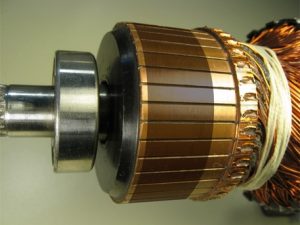Commutator principle
The principle is that when the coil passes the electric current, it will rotate under the action of the permanent magnet through the attraction and repulsion forces. When it is turned to balance with the magnet, the line that passes through the electric current is higher than the contact plate on the corresponding commutator. The brush is disconnected, and the brush is connected to a contact corresponding to the group of coils that produce the driving force, so that the DC motor is turned up repeatedly.
If there is no role of the commutator China, then the motor can only get stuck within less than half a turn and it can only be used as an electric brake. The use of the centrifugal force generated when the motor rotates as a power, control the size of the starting resistor, to reduce the motor starting current, increase the starting torque, so that the winding asynchronous motor to realize brushless automatic control device.
It mainly consists of housing, starting fluid, moving plate, spring, terminal, safety valve, exhaust valve and so on.
The liquid resistance starter has a small starting current, a large starting torque, automatic adaptation to changes in power supply and load, protection of the motor, etc. The commutator is a high-speed rotating device whose rotor windings are subjected to electric power and centrifugal force, although All of them have been operated under rated parameters, but the welding seams of the rotor windings and the commutator raising plate are the weak links of the commutator rotor. The traditional soldering process is adopted, and the rotor resistance is determined by combining the measurement results of the DC resistance between the plates. The looseness of the welding point between the winding and the commutator riser sheet causes fatigue of the end wire, which increases contact resistance, increases heat generation, accelerates oxidation of the contact surface, further increases contact resistance, and further increases heat generation. Such a vicious cycle will eventually result in the insulation of the commutator rotor being burned at high temperatures, arc discharge to the earth, and damage to the commutator.
The results of the commutator disassembly inspection show that the test data and the conclusions of the rotor winding test are accurate. In addition to the transmission of longitudinal currents, the motor commutator also has a current commutation task performed in the short-circuit armature coil.
These currents are the reverse current and reactance voltage generated when the main current motor commutator, causing the brush to cause sparks and arcs on the surface of the motor commutator. The effect of the motor commutator on the motor performance depends on In a certain premise, the circuit is turned on when the brush slides at a relatively high speed. Although the description of this process is rather complicated and theoretical research is still in progress, it can be determined that wear is the most important factor leading to the change of contact resistance through comparative analysis of the operating conditions of micromotors at home and abroad.

